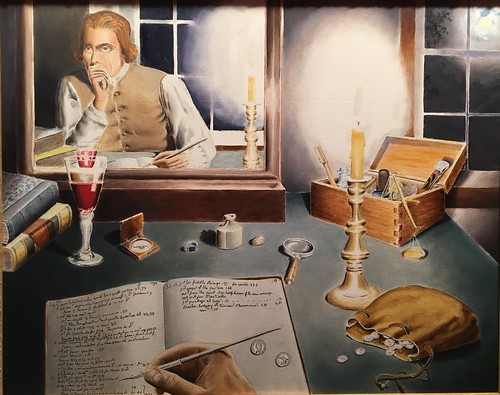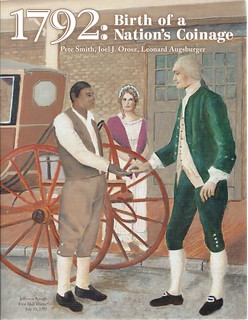
PREV ARTICLE
NEXT ARTICLE
FULL ISSUE
PREV FULL ISSUE
PAINTING RECREATES JEFFERSON'S COIN TRANSACTION
Numismatic artwork is a small but interesting genre.
A new painting commissioned by researcher and author Joel Orosz commemorates the moment when Thomas Jefferson recorded the first-ever transaction of coins produced by the United States mint. Thanks to Joel and Steve Roach of Coin World for this account.
-Editor
Paintings of scenes from American numismatic history have been created now for more than a century, but most artists have struggled to paint works of art that also get the history right. Steve Roach contributed a feature story, "Your Own Numismatic Masterpiece," to the July 16, 2018 issue of Coin World, telling how a newly-created painting has combined artistry with known historical facts. Author Joel J. Orosz commissioned artist Carlton Eddy of Helotes, Texas to paint a different kind of numismatic artwork, recreating, both aesthetically and accurately, an actual pivotal moment in the history of American numismatics.

Dunsmore: Washington Inspecting the First Money Coined by the United States The most familiar American numismatic historical painting is "Washington Inspecting the First Money Coined by the United States," painted in 1914 by artist John Ward Dunsmore on a commission from Frank H. Stewart, who had owned the last three remaining buildings of the first United States Mint. Dunsmore was a first-rate artist, and "Washington Inspecting" is a beautiful work of art. As history, however, the painting is pure bunk, depicting, as it does, a group of people who mostly never visited the Mint, attending a ceremony that never occurred, all set in a Mint building that did not exist in 1792. In the course of research for 1792: Birth of a Nation's Coinage, Orosz and co-authors Len Augsburger and Pete Smith discovered that Thomas Jefferson's Memorandum Book, a ledger of his personal household expenses, contained an extensive record of Jefferson's involvement with the creation and distribution of the first coin minted under the authority of the United States Constitution: the 1792 half disme. The Memorandum Book detailed how Jefferson delivered $75 worth of silver to the Philadelphia Mint on July 11, 1792, and received 1,500 half dismes on July 13, just before leaving for his summer vacation at Monticello. The first overnight stay on the 10-day journey was at an Inn located in Chester, Pennsylvania, about 15 miles southwest of center city Philadelphia, where, as Jefferson noted in his Memorandum Book, he paid 30 cents to "servts" in tips. This was the first unambiguously decimal transaction recorded in the Memorandum Book, and it means that these six 1792 half dismes Jefferson tendered comprised the first transaction using coins struck by the U.S. Mint: the first of many billions to come.
Eddy's oil painting depicts Jefferson seated in his room at the Inn, recording the day's events by glowing candlelight. Nearly every detail in the painting is modeled upon late 1790s originals, including Jefferson's travel box containing a set of coin scales. Jefferson's hand is visible making entries in the Memorandum Book, and Jefferson himself appears in the mirror on top of the table, where he is literally reflected, and also symbolically reflecting, on the significance of the day's momentous events. Half dismes spill from a pouch, and two have landed, obverse and reverse, on the open page of the Memorandum Book. More details about the Eddy painting, and on the process by which Orosz and Eddy co-created it, can be found in Steve Roach's July 16, 2018 Coin World feature story.

Eddy: Thomas Jefferson, Evening, July 13, 1792, Chester, Pennsylvania Carlton Eddy has been an official Coast Guard artist since 1988, and regularly paints aviation subjects for the U.S. Navy. Over the past few years, his artistic ambit has expanded to include numismatics, depicting coins, especially in historical settings. Eddy's clients have included Heritage Galleries and professional numismatists around the nation. His work is on display at, among other museums, those of the U.S. Naval Academy, and the National Museum of Naval Aviation in Pensacola. He may be reached at: sketcheddy@yahoo.com
The co-authors have created a new edition of 1792: Birth of a Nation's Coinage, limited to only 14
copies, featuring the Eddy painting, "Thomas Jefferson, Evening, July 13, 1792, Chester, Pennsylvania"
as the cover art, with the Smith painting, "The First U.S. Coin Enters Commerce, Chester, Pennsylvania,
July 13, 1792," as the book's frontispiece. Thirteen numbered copies have been distributed to the co-authors and to those who were especially helpful with the book's research and publication. One numbered copy will be offered as part of the Numismatic Bibliomania Society Benefit Auction, to be held
on August 17, 2018, at the NBS annual meeting during the 2018 ANA Convention.
The Numismatic Bibliomania Society is a non-profit organization promoting numismatic literature. See our web site at coinbooks.org. To submit items for publication in The E-Sylum, write to the Editor at this address: whomren@gmail.com To subscribe go to: https://my.binhost.com/lists/listinfo/esylum All Rights Reserved. NBS Home Page Contact the NBS webmaster 
|
